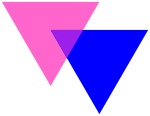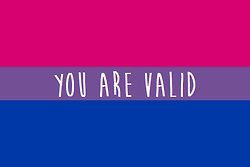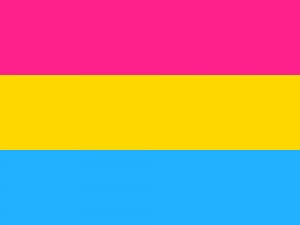Bi Identities Resources and Introduction
by Isabel Williams, College of Charleston
Updated: July 2021
Introduction:
The purpose of this page is to provide an introduction to understanding bisexual, pansexual, and fluid identities and to list resources that could be of use to people in those communities as well as family, friends, and partners. For those who identify as pansexual, fluid, or use other terms like queer, non-monosexual, etc., this guide may seem “bisexual heavy.” One should note, however, that the resources listed, while using “bi heavy” language, are for the most part committed to understanding and serving all of these communities under the umbrella of bisexuality.
For example the Bisexual Resource Center, the oldest group of its kind, notes “The BRC uses bisexual as an umbrella term for people who recognize and honor their potential for sexual and emotional attraction to more than one gender (pansexual, fluid, omnisexual, queer, and all other free-identifiers). We celebrate and affirm the diversity of identity and expression regardless of labels.” Language and personal ownership of identity are important, and this guide will highlight how individuals within the community use language rather than attempt to create a definitive glossary. This guide will also include a discussion of common misconceptions with community members speaking from their own experience to challenge rather than reify stereotypes. Collecting stories as a methodology is not unique to this page—many of the listed resources track the stories of a variety of people under the Bi umbrella. There’s even a 42-country anthology of biographical stories and poems called “Getting Bi: Voices of Bisexuals Around the World” edited by Robyn Ochs and Sarah Rowley.
Discussion of Terms:
Bisexual:
- UCLA Lesbian Gay Bisexual and Transgender Campus Resource Center: A person emotionally, physically, and/or sexually attracted to males/men and females/women. This attraction does not have to be equally split between genders and there may be a preference for one gender over others.
- The Bisexual Index: “This is how we define it: A bisexual is someone who is attracted to more than one gender. You might care about the gender of your partner a lot, a little, or not at all – but their gender doesn’t prevent you from being attracted to them.”
- Editor’s note: many people who use the term “bisexual” do not overstate gender-binaries and are attracted to people of all gender identities. see Bisexual Index Q&A and Bisexual.org Q&A
Pansexual :
- UCLA Lesbian Gay Bisexual and Transgender Campus Resource Center: “A person who is sexually attracted to all or many gender expressions”.
- Queers United: “Pansexuals have the capability of attraction to others regardless of their gender identity or biological sex. A pansexual could be open to someone who is male, female, transgender, intersex, or agendered/genderqueer.”
Queer:
- UCLA Lesbian Gay Bisexual and Transgender Campus Resource Center: “This term is sometimes used as a sexual orientation label instead of ‘bisexual’ as a way of acknowledging that there are more than two genders to be attracted to, or as a way of stating a non-heterosexual orientation without having to state who they are attracted to.”
Fluid:
- Bisexual.org : “The term fluid expresses the fact that the balance of a person’s homosexual and heterosexual attractions exists in a state of flux and changes over time. Usually, but not always, people who describe their sexuality as fluid are bisexuals whose attractions skew very heavily towards a particular gender. The terms Heteroflexible and homoflexible add a further level of specificity, by indicating whether the bisexual person’s attractions skew almost exclusively towards same-sex or different-sex individuals.”
Biphobia:
- UCLA Lesbian Gay Bisexual and Transgender Campus Resource Center: “The fear of, discrimination against, or hatred of bisexuals, which is often times related to the current binary standard. Biphobia can be seen within the LGBTQI community, as well as in general society.
- Editor’s note: in reference to the “current binary standard” concern: ‘Biphobia’ can be understood to affect those who may use another term. Many people who use the term “bisexual” do not overstate gender-binaries and are attracted to people of multiple gender identities see Bisexual Index Q&A and Bisexual.org Q&A.
- The Bisexual Index: “As bisexuals we face biphobia too, both from people that are homophobic and from ones who aren’t. It’s possible to be biphobic without being homophobic, as sayings like ‘you’re either straight, gay or lying’ make clear” See What is Biphobia?
- Robyn Ochs Ochs, Robyn. “Biphobia: It Goes More than Two Ways.” Bisexuality: The Identity and Politics of an Invisible Minority, Firestein, Beth. (ed.) Sage Publications, 1996
Community Members Discuss Terms:
Andrew Salman: “Depending on the context, the audience, and my mood, I could describe my sexual orientation as ‘bi,’ ‘pan’, ‘queer,’ ‘fluid,’ or even just ‘I dunno.’ To me, these terms overlap and are all accurate descriptors for me and my identity. I don’t feel the need to use just one or to draw hard lines between them.”
Robyn Ochs: “I call myself bisexual because I acknowledge that I have in myself the potential to be attracted – romantically and/or sexually – to people of more than one sex and/or gender, not necessarily at the same time, not necessarily in the same way, and not necessarily to the same degree.”
D. Andrew Porter: “Queer is an umbrella term for all sexualities/romantic identities. I use the term be inclusive of all gender identities and expressions when speaking about attraction.”
Isabel Williams: “When I first became aware of the word ‘bisexual’ I felt momentum and began to come out to myself – I knew it described me. I’m attracted to all kinds of people of different sizes, skin tones, sexes, and gender expressions. I use the term bisexual because I want to counter negative stereotype associated with this word by living authentically and simultaneously disproving many of these stereotypes. “
Megan Berry: “I identify mostly as ‘queer’ but out loud to other people I usually use ‘pansexual’. When I’m in a queer environment people usually want more clarification than ‘I’m queer’; but what I would really like to say is that ‘I’m sexual’, that I feel my sexual orientation is so fluid that it doesn’t suffice to represent myself singularly or with limitations. It sounds cheesy, I know, but I’m more concerned with who you are than what you are.”
Roze Brooks: “I’ve been using ‘biromantic’ more than ‘bisexual’ lately because ‘biromantic’ for me means I have the capacity to be emotionally or romantically attracted to a person of the same or a different gender. I’m a little more reserved and limited in who I am physically or sexually attracted to.”
Symbols:
Bisexual Pride Flag: The Cantú Queer Center at the University of California Santa Cruz: “The bisexual pride flag was designed by Michael Page in 1998 in order to give the bisexual community its own symbol comparable to the Gay pride flag of the larger LGBT community. His aim was to increase the visibility of bisexuals, both among society as a whole and within the LGBT community. The deep pink or rose stripe at the top of the flag represents the possibility of same gender attraction; the royal blue stripe at the bottom of the flag represents the possibility of opposite gender attraction and the stripes overlap in the central fifth of the flag to form a deep shade of lavender or purple, which represents the possibility of attraction anywhere along the entire gender spectrum.”
Bisexual Triangles or “Biangles”: The “biangles” were designed by Boston bisexual activist Liz Nania in the mid-1980s.

Pansexual Pride Flag: The Cantú Queer Center at the University of California Santa Cruz: “The pink stripe represents female gendered people, the gold stripe represents those who identify as mixed gender, genderless, or third gender, and the blue stripe represents male-gendered people. This encompasses the genders that pansexual people are attracted to – that is, everyone! It appeared on the internet in the middle of 2010. The original creator is unknown.”
Discussion- Myths and Misconceptions:
Rebby Kern: “The world doesn’t function according to single set of rules, especially not when it comes to sexuality and attraction. I’ve been challenged by folks, from within the LGBTQ community and outside of the spectrum, about how my bisexuality makes me less of an LGBTQ person. My attraction to the range of genders was seen as selfish and unsure. My heart has been pulled towards people and their entire being. There haven’t been trends in the people I’ve shared my journey with except that they loved me. I suppose I’ve been able to see love without gender. “
Isabel Williams: The first question I get when I tell people I’m in a serious relationship with a man is always “Does he know you are bisexual?” I am very “out” on and off campus, and I am surprised at the expectations that folks have for my partner. He is perfectly aware, it doesn’t “freak him out”, and no, he is not with me for fetishizing reasons. To both our credit our relationship is built on honesty and respect. My gender expression is feminine and I’m dating a man, but I’m not trying to hide anything. I don’t enjoy my identity being erased any more than anyone else.”
Roze Brooks: “I experience the assumption that since I’m primarily attracted to female-bodied individuals, that I can’t possibly be attracted to anyone else. Or inversely, because I’ve been attracted to male-bodied individuals in the past, that I can’t possibly be attracted to anyone else. People try to tell me that I fall on one end of the binary all the time based on what my attractions were at a single point in my life.”
Erin Healy: “I identity as bisexual. There are many misconceptions out there about bisexuality, however one I have continually faced is the idea that I’m just confused. We live in a world in which we categorize things into boxes, and that includes sexuality. Bisexual does not neatly fit into the “gay” or “straight” box, so many people believe it is not a valid identity and it is a stepping point from straight to gay.”
Learn More: The Bisexual Index has a really comprehensive “Bisexuality FAQ” page that attempts to “debunk” some of the myths surrounding bisexuality. The Bisexual.org Q&A tab also answers common questions and assumptions related to bisexuality and includes a combination of answers form the site creators and individuals sharing their own experience.
Resources:
The Bisexual Resource Center: “The BRC is the oldest national bi organization in the U.S. that advocates for bisexual visibility and raises awareness about bisexuality throughout the LGBT and straight communities.” Site includes a bisexual fact sheet and a bisexual community presentation powerpoint, a map of bisexual community groups in the US. Resources include the “How to be an Ally to a Bisexual Person”, and Ask Tiggy an advice and question and answer tool.
BiNet USA: “A 501(c)(3) non-profit advocating for bisexual communities in the U.S” Site includes a bisexual fact sheet and a bisexual community presentation powerpoint, a map of bisexual community groups in the US. Resources include the “How to be an Ally to a Bisexual Person”, and Ask Tiggy an advice and question and answer tool.
American Institute of Bisexuality: Founded in 1998 by Dr. Fritz Klein, “The American Institute of Bisexuality encourages, supports and assists research and education about bisexuality, through programs likely to make a material difference and enhance public knowledge, awareness and understanding about bisexuality.”
Bi Women Quarterly is a quarterly grassroots publication for women who identify as bisexual or in one of the other middle sexualities. Each issue focuses on a theme and your writing, artwork and news is welcome. Electronic subscriptions are free and—if you have an office or resource center where copies can be displayed for public use—free print subscriptions are also available upon request.
Bisexual.org this fresh looking website is a project of the American Institute of Bisexuality in which community members can tell their stories by creating a profile. Also, find bios of famous bisexuals– incredible!
Huff Post Bisexual: Everything you love about Huff Post, Bisexual-specific! Read and watch to your hearts content: human interest an celebrity pieces as well as policy and research news.
Advocate-Bisexuality: Bisexual Op-Eds and News from the Advocate.com!
- Read the op-ed by Campus Pride’s very own Rebby Kern “I’m going back to Bi: Confessions of a former lesbian”
- See also “Exploring the Umbrella: Bisexuality and Fluidity” by Trudy Ring for more information on fluid sexualities.
Robyn Ochs: is a nationally known openly bisexual activist working for the well-being of people of all sexual orientations and gender identities. Robyn’s webpage includes additional resources as well as more information about Getting Bi the 42-country anthology which she co-edited. She is also a member of the Campus Pride Speakers Bureau- Bring Robyn to your campus!
UPDATE: 8/8/14
Editor’s Note: In response to requests to address the important terms “bisexual erasure” and “bisexual invisibility”, the following information is provided to serve as a very basic introduction to an unfortunately pervasive phenomenon.
Bisexual Erasure and Invisibility:
- The Bisexual Resource Center: How to be an Ally to a Bisexual Person (brochure): “Believe that I exist. Despite ongoing scientific research that seems so determined to disprove the existence of bisexuality, plus the general lack of interest by the greater gay and lesbian community to acknowledge us, we really do exist. When I tell you I’m bisexual, please don’t try to talk me into redefining my identity into something more comfortable for you.”
- The Bisexual Index: “Bisexual erasure is rampant. We’re gay when we have same-sex partners, straight when we have different-sex ones. As soon as a previously thought-of as “straight” celebrity has come out as bi and they’re then seen with someone of the same-sex, it’s described as a “gay fling” or they’ve got a “lesbian crush”.
- National Gay and Lesbian Task Force: “Bisexuals overlooked in Marriage Debate”: When Robyn Ochs married her partner Peg Preble in the first same-sex marriage in Massachusetts The Washington Post Peg refereed to them as a “lesbian couple” despite Robyn’s openness about her bisexuality and her considerable contributions to the bisexual community.
- Editor’s note: “Bisexual Erasure and Invisibility” can be understood to affect those who use other terms for their non-monogamous identities. Please read the discussion of Common Misconceptions by community members on this page and the Bisexual Index‘s “Bisexuality FAQ” page that attempts to “debunk” some of the myths surrounding bisexuality and the Bisexual.org Q&A for more examples of bisexual erasure and invisibility.
Isabel Williams is a 2014 Summer Fellow at Campus Pride. She is a rising senior at the College of Charleston studying Political Science. Isabel is the Student Organizer for College of Charleston’s SafeZone program and the president of the Gay-Straight Alliance. Learn more about Isabel


